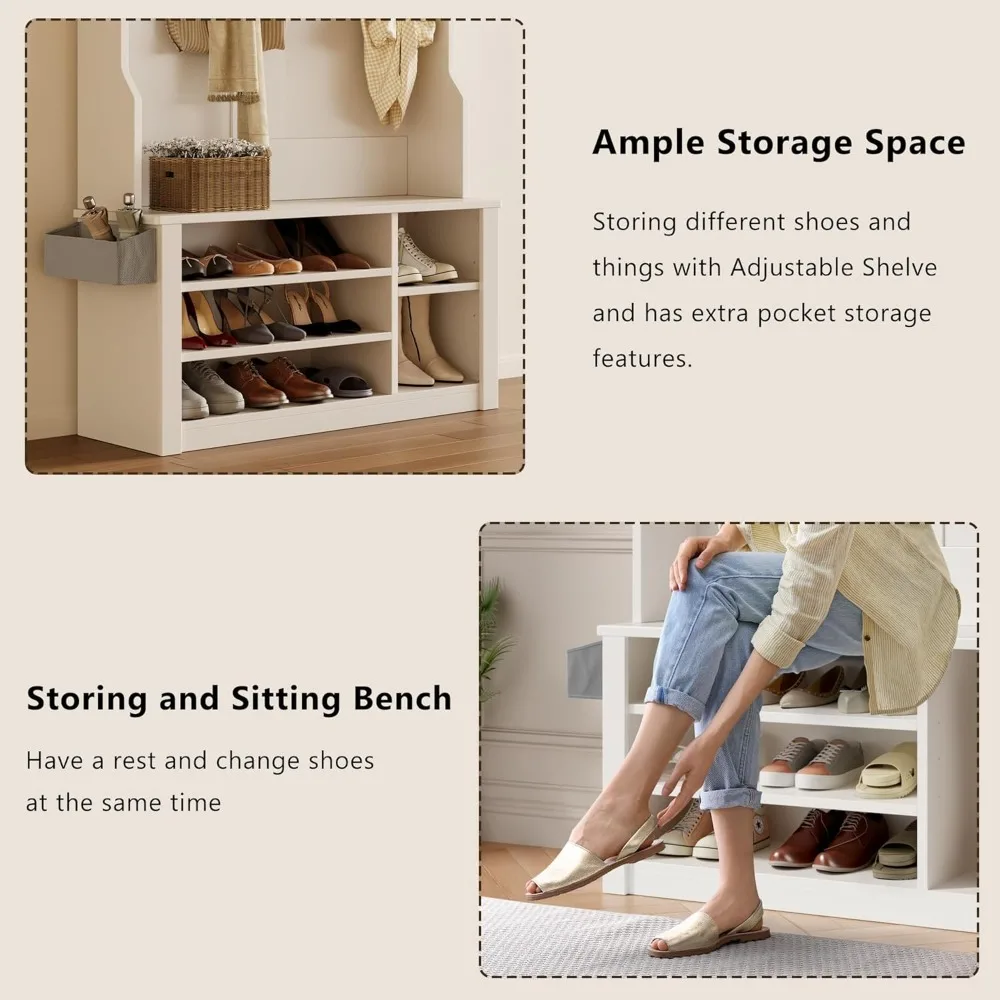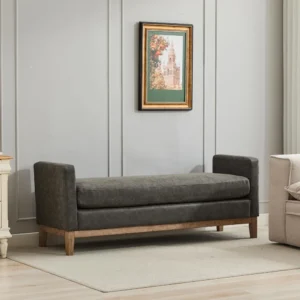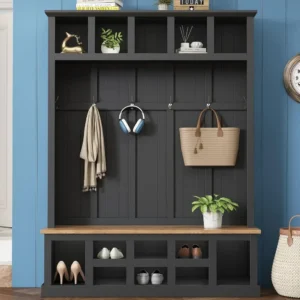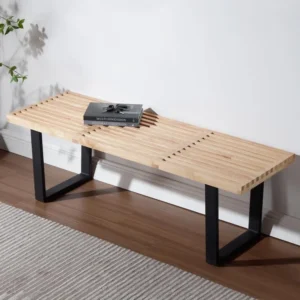Understanding the Small-Space Mudroom Challenge
Walking through the front door only to step on scattered shoes, trip over sports equipment, and navigate around piles of coats is a daily frustration for many homeowners with limited entryway space. Small mudrooms present unique organizational challenges that can impact your entire home experience. With most compact mudrooms measuring just 15-25 square feet (compared to standard mudrooms at 35+ square feet), the space crunch is real and often overwhelming.
The average family of four needs storage space for at least 8-12 pairs of seasonal shoes, 4-8 coats, multiple bags, and various accessories like umbrellas, hats, and gloves. Without proper organization, these items quickly transform an entryway from welcoming to chaotic.
A well-organized mudroom does more than just look nice—it fundamentally improves your daily routine. When you can easily find your keys, grab the right coat, and locate matching shoes without a frantic search, your mornings start smoother and your evenings end more peacefully. Proper mudroom benches serve as the foundation for creating this organized entryway environment, providing both seating and storage in one compact solution.
The good news is that even the smallest spaces can be transformed with smart storage strategies. Whether your challenge involves a growing family’s collection of gear, seasonal item rotation, or simply making a tiny space work harder, solutions exist for every situation. With thoughtful planning and the right combination of furniture and organizational tools, your small mudroom can become a model of efficiency rather than a source of daily frustration.
Before implementing any storage solutions, understanding how to organize small entryway bench areas is essential for creating a system that works for your specific needs. This foundation will help you select the right solutions that truly address your space constraints and lifestyle requirements.
Core Principles for Maximizing Small Mudroom Spaces
Successfully organizing a small mudroom requires embracing several fundamental principles that will guide all your storage decisions. These core concepts will help you maximize every inch of available space while maintaining functionality and style:
Think Vertically
When floor space is limited, your walls become valuable real estate. Vertical storage utilizes space that would otherwise go unused. Studies show that implementing vertical storage solutions can increase usable space by up to 40% in small areas. From floor to ceiling, every inch of wall space offers potential storage opportunities.
Prioritize Multi-Functionality
In small spaces, every item should earn its keep by serving multiple purposes. Multi-functional furniture typically saves 30-40% of space compared to using separate pieces for each function. For example, a bench that provides seating while also storing shoes and bags eliminates the need for three separate items.
Embrace Hidden Storage
Look for opportunities to conceal items within furniture, behind doors, or in unexpected spaces. This approach reduces visual clutter, making the space feel larger and more organized. Hidden storage also protects items from dust and creates a cleaner aesthetic.
Declutter First
Before implementing any storage solution, ruthlessly assess what items truly need to be stored in your mudroom. Many organizational experts recommend the one-in, one-out rule: for every new item that enters your mudroom, an old one should leave.
Choose Durable Materials
Mudrooms endure heavy traffic and exposure to the elements. Materials should withstand moisture, dirt, and constant use. Solid wood rates excellent for durability but requires maintenance, while metal offers exceptional strength but may feel cold. Quality laminate provides good durability with less maintenance at a more accessible price point.
Customize to Your Household
The most effective storage systems address your family’s specific needs. Consider family size, ages, activities, and daily routines when designing your storage solutions. A household with young children needs different solutions than one with teenagers or adults only.
Implementing these core principles requires thoughtful planning and sometimes creative problem-solving. Various space-saving entryway ideas can help you visualize how these principles translate into practical applications for your specific situation.
Remember that effective small-space organization isn’t about following rigid rules—it’s about finding the right combination of solutions that work for your unique space and lifestyle. The following sections will explore specific strategies for applying these principles to different aspects of mudroom storage.
Wall-Mounted Storage Solutions: Reclaiming Vertical Space
When floor space is at a premium, your walls become the most valuable asset in your storage arsenal. Wall-mounted solutions allow you to capitalize on vertical space while keeping floors clear and the room feeling spacious.
Strategic Hook Systems
Hooks are the workhorses of mudroom organization, but their effectiveness depends on proper selection and placement:
- Standard Utility Hooks: Support 5-10 pounds, ideal for lightweight items like hats and scarves
- Heavy-Duty Mounted Hooks: Hold 15-25 pounds, perfect for backpacks and winter coats
- Decorative Cast Iron Hooks: Combine strength (20+ pounds) with style
- Placement Tip: Install hooks at appropriate heights for different family members—approximately 48 inches (122 cm) for children and 60-66 inches (152-168 cm) for adults
For maximum organization, create dedicated zones with hooks clustered by family member or by item type (coats separate from bags).
Shelving Options
Floating shelves provide storage without the visual bulk of cabinets, making small spaces feel more open:
- Slim Floating Shelves: Extend just 6-8 inches (15-20 cm) from the wall while providing display and storage space
- Bracket Shelves: Offer more weight capacity for heavier items
- Adjustable Track Systems: Allow modification as storage needs change
Position shelves above hooks to create complete vertical storage stations. Lower shelves work well for frequently used items, while higher shelves are perfect for seasonal or less-used belongings.
Pegboard Installations
Pegboards offer unmatched customization in small spaces:
* Easily reconfigure with various accessories (hooks, baskets, shelves)
* Available in different materials including metal, wood, and plastic
* Can be painted to match your décor
* Perfect for storing smaller items that would otherwise get lost
Narrow Wall Cabinets
For items you’d prefer to keep concealed, slim wall cabinets provide the perfect solution:
* Look for cabinets just 4-5 inches (10-13 cm) deep
* Choose options with adjustable interior shelving
* Consider mirrored doors to make the space feel larger
* Ideal for storing cleaning supplies, winter accessories, or personal care items
The right combination of entryway furniture with shoe compartments and wall-mounted storage creates a comprehensive organization system without consuming precious floor space. Vertical solutions can dramatically transform even the tiniest mudroom into a highly functional space.
When selecting wall-mounted options, ensure your choices complement other elements like bench hooks and storage systems to create a cohesive solution. The best mudroom designs integrate multiple storage types that work together seamlessly.
Multi-Functional Seating: Storage Where You Sit
A well-designed storage bench serves as the cornerstone of most small mudroom solutions, providing essential seating while maximizing storage capacity. These multi-tasking pieces eliminate the need for separate furniture items, making them perfect for compact spaces.
Storage Bench Styles
Different bench designs offer unique storage advantages:
Lift-Top Storage Benches: Provide large, concealed storage compartments perfect for bulky items like sports equipment, pet supplies, or seasonal gear. The entire seat lifts to reveal storage underneath.
Cubby-Style Benches: Feature open compartments below the seating surface, offering easy access and visual organization. Ideal for daily-use items and when paired with storage baskets.
Drawer-Based Designs: Include pull-out drawers beneath the seating area, providing more organized and separated storage while keeping items concealed and dust-free.
Space Requirements
When selecting a storage bench for a small mudroom, carefully consider dimensions:
- Depth: Most functional benches require 15-18 inches (38-46 cm) of depth
- Width: Small-space options start at just 24 inches (61 cm) wide
- Height: Standard seating height is 17-19 inches (43-48 cm)
- Clearance: Allow at least 24 inches (61 cm) in front for comfortable sitting and standing
Material Considerations
The materials used in your storage bench determine its durability and longevity:
- Solid Hardwood: Offers exceptional durability and timeless appeal but requires occasional maintenance
- Engineered Wood: Provides good stability at a lower price point
- Metal Frames: Add strength and modern style, often combined with wood or upholstered elements
- Quality Hardware: Look for reinforced hinges on lift-top models and smooth-gliding drawer mechanisms
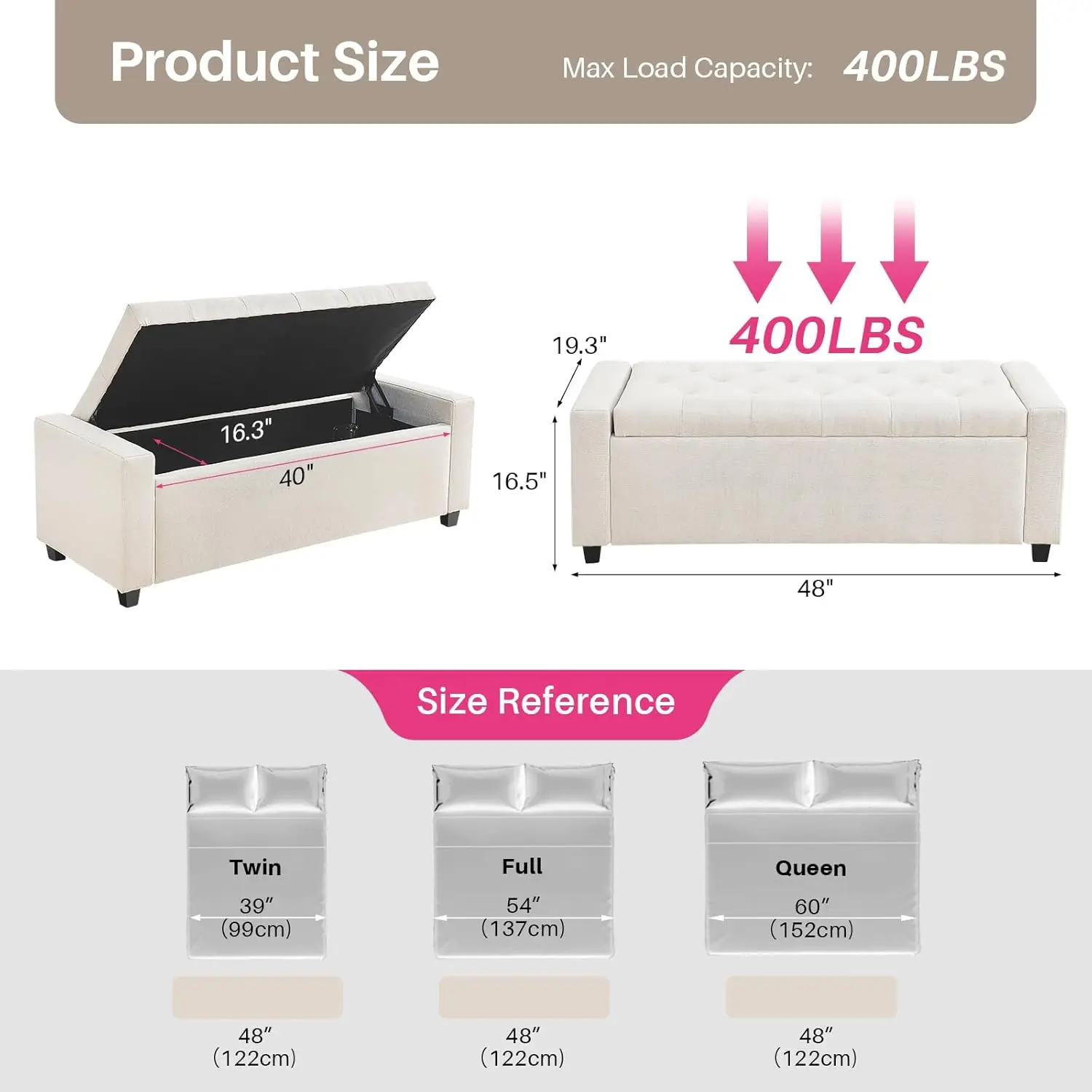
Premium entryway bench storage solutions combine thoughtful design with superior materials, ensuring your investment continues performing well year after year. The best options feature details like soft-close hinges, dovetail drawer construction, and moisture-resistant finishes that stand up to wet boots and damp gear.
When placing a storage bench in a small mudroom, position it against the shortest wall to maximize flow through the space. This arrangement creates a natural “drop zone” while leaving the majority of the room open. For extremely tight spaces, explore specialized space-saving entry benches for small homes designed specifically for minimal footprints.
Innovative Shoe Storage Systems for Limited Floor Space
Shoe clutter is often the biggest challenge in small mudrooms. The average household needs storage for 3-4 pairs of shoes per person, which quickly overwhelms limited floor space. Thankfully, innovative shoe storage solutions can organize footwear while maintaining an open, uncluttered environment.
Vertical Shoe Rack Solutions
Vertical shoe organization dramatically reduces floor footprint:
- Wall-Mounted Shoe Racks: Hold shoes perpendicular to the wall, reducing depth requirements to just 5-7 inches (13-18 cm)
- Over-Door Shoe Organizers: Utilize otherwise unused space
- Tiered Vertical Racks: Store twice as many shoes as horizontal storage in the same floor space
These vertical systems can store up to 10 pairs of shoes per square foot compared to just 2-3 pairs with traditional floor storage methods.
Slim-Profile Shoe Cabinets
For a more concealed solution, slim cabinets offer elegant organization:
- Tilt-Out Shoe Cabinets: Require just 6-8 inches (15-20 cm) of depth while storing multiple pairs
- Narrow Towers: Utilize vertical space with a minimal footprint
- Shoe Storage with Seating: Combines two essential mudroom functions
Look for cabinets with appropriate ventilation to prevent odor buildup and allow damp shoes to dry properly.
Under-Bench and Hidden Solutions
Integrating shoe storage within other mudroom elements maximizes efficiency:
- Bench Cubbies: Provide open storage beneath seating
- Pull-Out Shoe Drawers: Conceal footwear while allowing easy access
- Boot Trays: Contain moisture and dirt from wet footwear
Weather-Ready Solutions
Mudrooms must accommodate both clean everyday shoes and muddy, wet boots:
- Boot Trays with Drainage: Protect flooring while allowing boots to dry
- Ventilated Storage: Prevents mildew and odors
- Water-Resistant Materials: Ensure longevity despite exposure to the elements
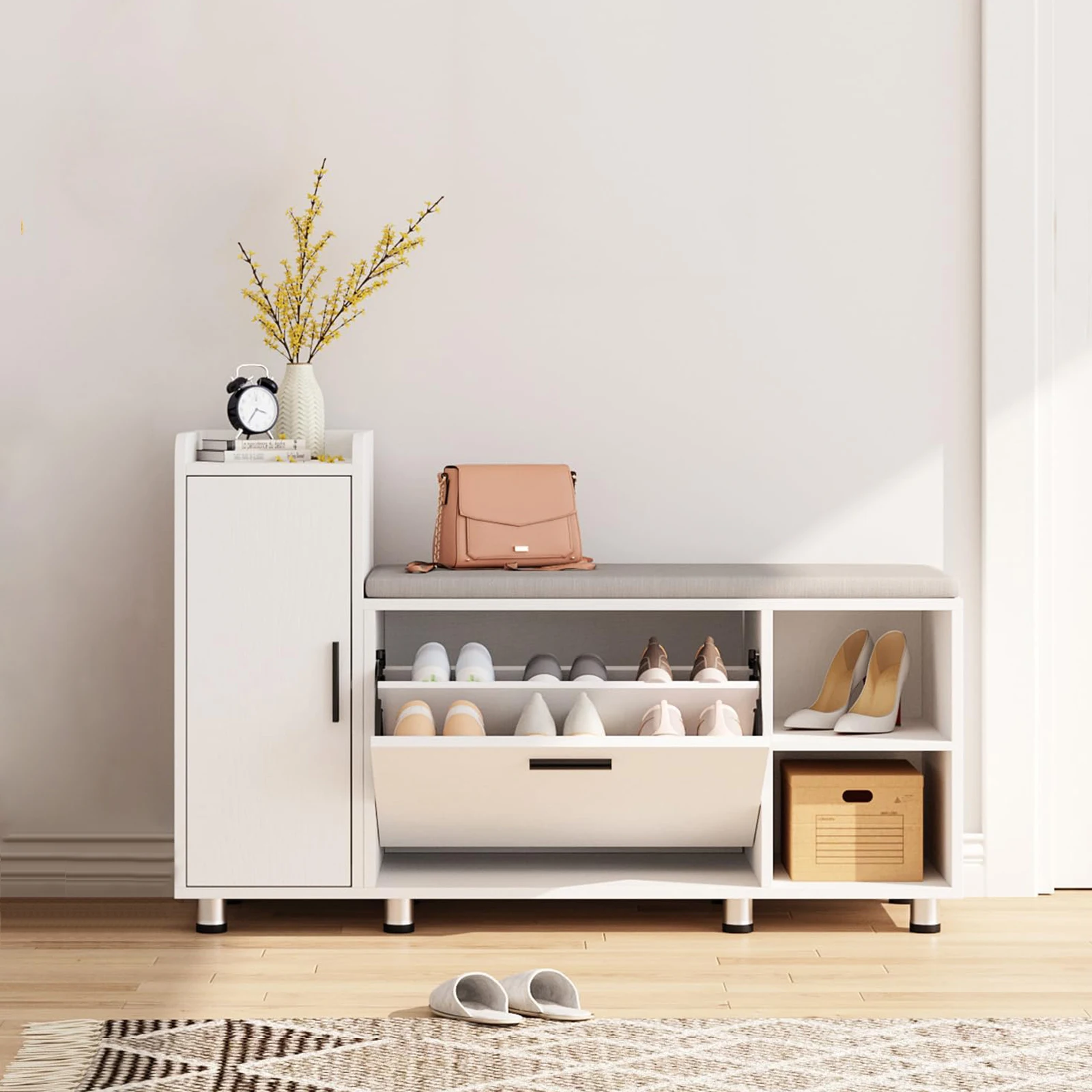
Quality shoe bench mudroom solutions combine thoughtful design with premium materials that withstand daily use. The best options feature details like removable boot trays, moisture-resistant finishes, and proper ventilation.
For extremely limited spaces, explore best small benches for entryways that incorporate shoe storage in innovative ways. These space-conscious designs prove that even the tiniest mudroom can accommodate essential shoe organization without feeling cramped.
Small-Space Container Solutions: Baskets, Bins, and Cubbies
The secret to maintaining organization in small mudrooms lies in effective containerizing. Strategic use of baskets, bins, and cubbies creates order within your larger storage systems, preventing small items from becoming clutter.
Strategic Container Selection
Different items require different container types:
- Open Baskets: Ideal for frequently accessed items like hats and gloves
- Lidded Bins: Perfect for seasonal storage and less-used items
- Clear Containers: Make contents visible for easy identification
- Fabric Bins: Add softness and texture while providing flexible storage
- Rigid Containers: Offer structure for awkwardly shaped items
Select containers specifically sized for your storage furniture to maximize space efficiency. Avoid oversized options that waste valuable space or undersized containers that leave items spilling over.
Material Considerations
Container materials should be chosen based on use and placement:
- Woven Natural Fibers: Add warmth and texture but may not be ideal for wet items
- Wire Baskets: Provide ventilation for damp items but don’t contain small objects
- Plastic Bins: Offer water resistance and easy cleaning
- Canvas Bins: Combine durability with softness and are often washable
- Wooden Crates: Add rustic charm while providing sturdy storage
Sizing Guidelines
For maximum efficiency in small spaces:
* Measure storage areas before purchasing containers
* Allow 1-2 inches of clearance for easy removal
* Choose stackable options when possible
* Consider nesting containers for seasonal rotation
Family Organization Systems
Creating a personalized organization system ensures everyone can maintain order:
- Assign color-coded containers to each family member
- Implement simple labeling systems that work for all ages
- Position children’s containers at accessible heights
- Create “incoming” and “outgoing” bins for items that need attention
Our mudroom bench cubbies offer integrated organization with designated spaces for baskets and containers, creating complete storage systems within a single furniture piece.
Remember that the most effective container solutions work within your existing habits rather than requiring entirely new behaviors. Select options that make organization easier, not more complicated, and position them where items naturally tend to be placed.
Creating Mudroom Functionality in Entryways Without Dedicated Spaces
Not every home has the luxury of a dedicated mudroom, but that doesn’t mean you can’t create equivalent functionality. By thoughtfully defining and equipping a portion of your entryway, you can establish an organized “drop zone” that serves the same purpose.
Defining Your Drop Zone
Even without walls to define your space:
- Use furniture placement to create visual boundaries
- Establish a consistent location for incoming and outgoing items
- Limit the defined area to 3-5 feet (0.9-1.5 meters) of wall space
- Choose a location that naturally aligns with your home’s traffic flow
Space-Efficient Furniture Solutions
Several furniture pieces can create instant mudroom functionality with minimal footprint:
- Narrow Hall Trees: Combine hooks, shelving, and sometimes seating in a slim profile as narrow as 12 inches (30 cm) deep
- Wall-Mounted Entry Organizers: Provide hooks and small shelves with zero floor footprint
- Slim Console Tables with Storage: Offer a surface for keys and mail while storing items beneath
- Nesting Furniture: Includes pieces that can be pulled out when needed and tucked away when not in use
Utilizing Awkward Spaces
Often, the most challenging areas can become the most useful:
- Corner Installations: Transform unused corners with specifically designed corner furniture
- Under-Stair Areas: Convert this often-wasted space into storage nooks
- Narrow Hallways: Use slim wall-mounted solutions that extend just 6-8 inches (15-20 cm) from the wall
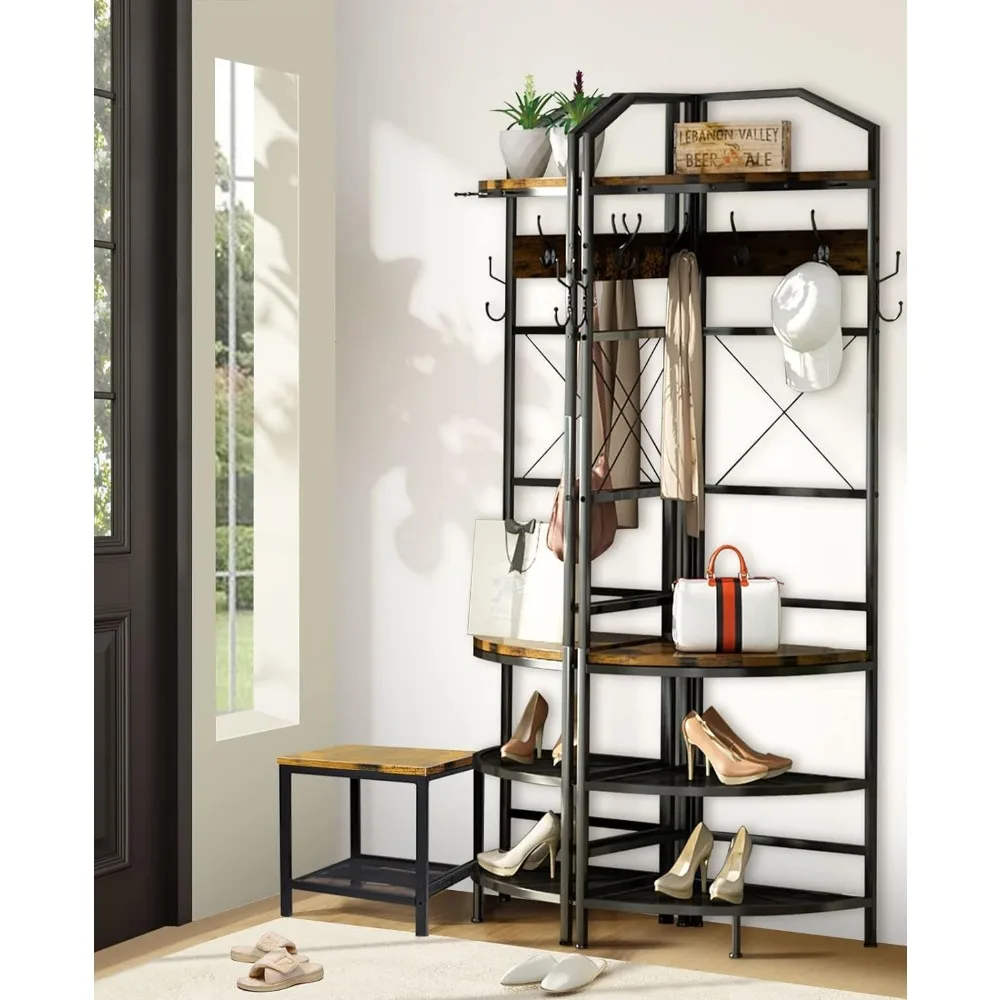
Specialized corner hall tree solutions make particularly efficient use of often-overlooked corner spaces, combining multiple storage functions in areas that typically go unused. These pieces can transform a dead corner into the most functional part of your entryway.
For homes with extremely limited space, consider maximizing small spaces with smart entryway bench designs that incorporate multiple functions into one compact piece. The best small-space solutions disappear into the background visually while providing essential organization right where you need it.
Creative DIY and Budget-Friendly Storage Hacks
Not every storage solution requires a significant investment. With some creativity and basic tools, you can create custom solutions that address your specific needs without breaking the bank.
Simple Shelf and Hook Installations
Even beginners can tackle these projects:
- Floating Shelf with Hooks: Install a simple floating shelf with hooks mounted underneath. Materials cost: $25-45.
- Repurposed Board Mount: Transform a vintage board or reclaimed wood into a unique hook system by adding decorative hooks. Materials cost: $15-30.
- Tension Rod Shoe Storage: Install a tension rod 6-8 inches off the floor inside a closet to create instant heeled shoe storage. Materials cost: Under $10.
Each of these projects requires only basic tools like a drill, level, and screwdriver, with an estimated time investment of 1-2 hours.
Upcycling Opportunities
Give new life to existing items:
- Transform an old dresser into bench seating by removing top drawers and adding cushions
- Repurpose kitchen cabinets as mudroom storage with new paint and hardware
- Convert wooden crates into wall-mounted storage bins
- Use vintage suitcases as decorative storage for seasonal items
Affordable Container Alternatives
Think beyond standard storage containers:
- Clean paint cans with decorative wraps make perfect umbrella holders
- Coffee cans covered in fabric organize small accessories
- Repurposed mason jars store small items like keys and sunglasses
- Wine crates function as shoe storage cubbies
These creative solutions complement more substantial pieces, allowing you to fill organizational gaps without additional large furniture. The combination of DIY elements with premium affordable entryway bench solutions creates a comprehensive system that addresses all your storage needs while respecting your budget constraints.
Remember that DIY solutions work best when they’re designed for your specific needs rather than copied directly from online tutorials. Measure your space carefully, consider your family’s unique habits, and customize your projects accordingly.
Entryway Bench with Cushion, Mudroom Bench with Cushion, Shoe Bench for Entryway
$1,186.63 Select options This product has multiple variants. The options may be chosen on the product pageCoat Rack Shoe Bench, Corner Entryway Bench, Corner Hall Tree, Shoe Bench for Entryway
$313.58 Select options This product has multiple variants. The options may be chosen on the product pageEntryway Bench with Back, Modern Entryway Bench, Shoe Bench for Entryway
Price range: $463.13 through $474.44 Select options This product has multiple variants. The options may be chosen on the product pageCorner Entryway Bench, Entryway Bench with Cushion, Modern Entryway Bench, Shoe Bench for Entryway
$476.34 Select options This product has multiple variants. The options may be chosen on the product pageBench with Hooks and Storage, Entryway Hall Tree, Mudroom Bench with Cubbies, Mudroom Bench with Shoe Storage
$818.38 Select options This product has multiple variants. The options may be chosen on the product pageModern Entryway Bench, Wood Entryway Bench, Wood Mudroom Bench
$497.69 Select options This product has multiple variants. The options may be chosen on the product page
Design Strategies: Creating a Stylish Small Mudroom
A well-organized mudroom doesn’t have to sacrifice style for functionality. Thoughtful design choices can create a space that not only serves its practical purpose but also enhances your home’s aesthetic appeal.
Color Selection for Small Spaces
Strategic color choices make a significant impact on how spacious your mudroom feels:
- Light, cool colors (soft blues, greens, and grays) visually expand space
- Monochromatic color schemes create a sense of continuity
- High-contrast colors can define zones but may make the space feel smaller
- Matching wall color to storage furniture creates a seamless look
Using color psychology principles for small spaces suggests that painting walls, trim, and built-ins in the same color can make a small mudroom feel up to 30% larger by eliminating visual breaks.
Material Coordination
Creating visual cohesion through materials:
- Limit material palette to 2-3 complementary textures
- Choose consistent metal finishes for hardware (hooks, handles, and rods)
- Balance hard surfaces (wood, metal) with soft elements (cushions, textiles)
- Consider durability alongside aesthetics—beautiful materials must also withstand daily use
Space-Enhancing Lighting
Proper lighting transforms both the function and feel of small spaces:
- Install lighting at multiple heights to eliminate shadows
- Consider motion-activated options for convenience
- Use under-shelf lighting to illuminate dark corners
- Choose fixtures with a slim profile to preserve headroom
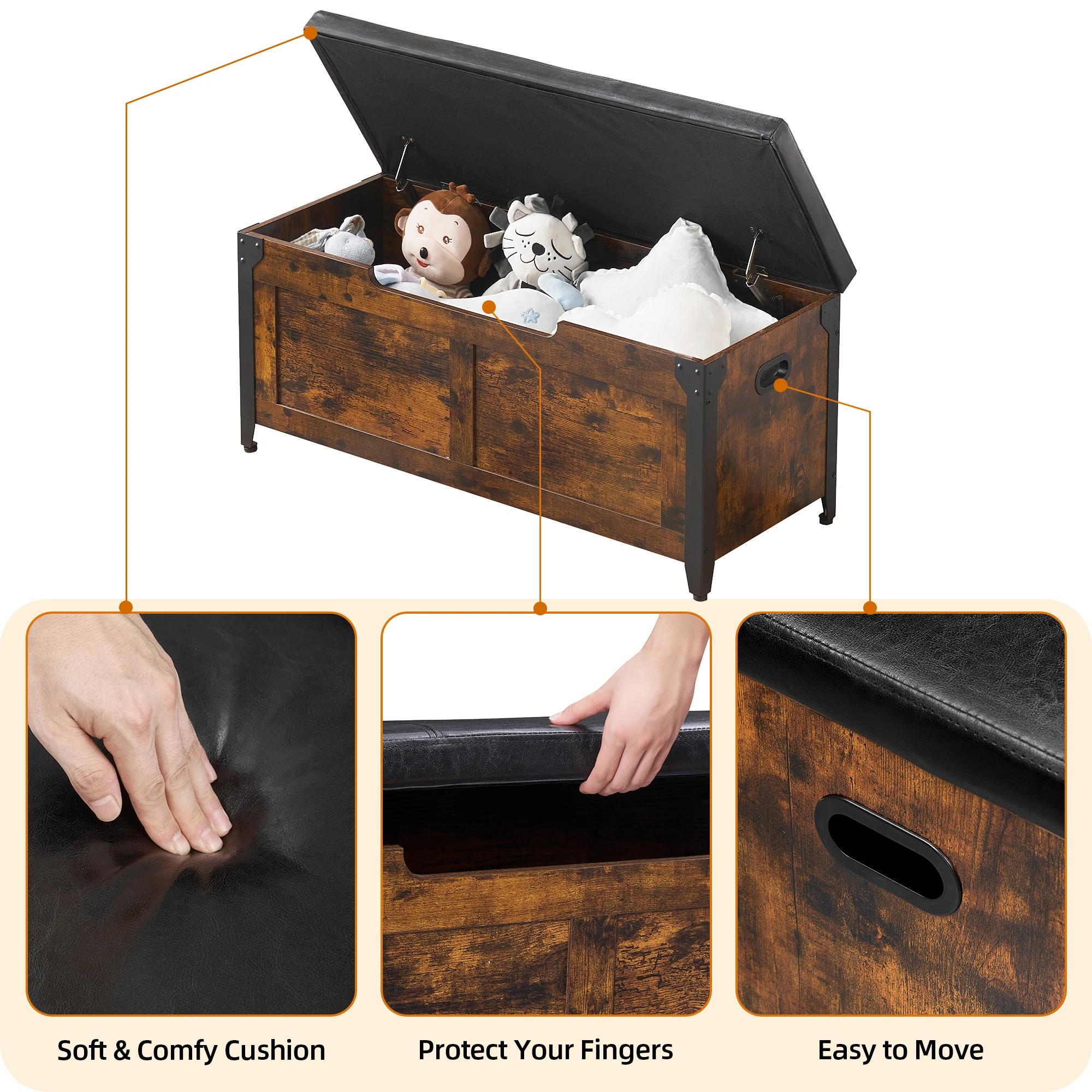
Our modern entryway bench collection exemplifies how premium design can transform a functional piece into a style statement. These pieces feature clean lines, quality materials, and thoughtful details that elevate the entire entryway.
For contemporary homes, exploring modern bench styles for small spaces provides inspiration for integrating organization solutions that complement your home’s existing design language. The most successful mudroom designs don’t feel like utilitarian afterthoughts but rather natural extensions of your home’s overall style.
Customizing Your Storage System for Specific Household Needs
The most effective storage systems are tailored to your household’s unique composition and routines. One-size-fits-all solutions rarely address the specific challenges faced by different types of families.
Family-Specific Considerations
Different household members require different accommodations:
- Children: Install hooks and storage at lower heights (36-42 inches/91-107 cm) and consider growth when planning vertical storage
- Teens: Provide extra space for sports equipment and electronics storage
- Adults: Position primary storage at comfortable heights (48-66 inches/122-168 cm)
- Seniors: Prioritize easy-access storage that doesn’t require bending or reaching
- Mixed-Height Households: Create tiered storage zones to accommodate everyone
Pet Owner Adaptations
For households with furry family members:
- Designate space for leashes, toys, and pet accessories
- Create washable bedding areas
- Store pet food in sealed containers
- Include hook space for walking essentials
- Consider built-in feeding stations that can be tucked away
Seasonal Adjustment Strategies
Your storage needs change throughout the year:
- Create an accessible “current season” zone for daily-use items
- Designate less accessible “off-season” storage for items not currently needed
- Implement a seasonal rotation schedule (typically quarterly)
- Use vacuum storage bags for bulky winter items during summer months
Understanding the appropriate perfect entryway bench height for your family members ensures comfortable use and accessibility for everyone. The ideal height varies based on primary users—lower for children-focused households and standard height (17-19 inches/43-48 cm) for adult households.
For multi-generational homes or families with diverse needs, space-saving entryway seating solutions offer versatile options that can accommodate various requirements without consuming excessive space. These adaptable pieces serve different family members equally well while maintaining organization.
Advanced Space-Maximizing Techniques for Tiny Mudrooms
When working with truly minimal space—perhaps just a few square feet—standard solutions may not be sufficient. These advanced techniques push space efficiency to its limits, making even the tiniest areas functional.
Ultra-Slim Storage Units
For extremely narrow spaces:
- Depth-Minimizing Designs: Look for units just 6-8 inches (15-20 cm) deep
- Wall-Hugging Profiles: Choose furniture that sits flush against walls
- Floating Designs: Select pieces that mount directly to walls, eliminating legs that consume floor space
- Tapered Furniture: Consider units narrower at the bottom than top to preserve walkway space
Hidden and Recessed Storage
Create storage where none seems possible:
- Between-Stud Recessed Cabinets: Build storage within wall cavities (typically 3.5 inches/9 cm deep)
- Under-Floor Storage: Implement trap door storage in appropriate locations
- Over-Door Solutions: Utilize the often-forgotten space above doorways
- Pull-Out Vertical Cabinets: Install narrow cabinets that pull out rather than open outward
Fold-Away Solutions
Implement storage that appears only when needed:
- Wall-Mounted Drop Stations: Fold down for use and up when not needed
- Collapsible Hanging Systems: Expand when in use, contract when not
- Nesting Furniture: Smaller pieces tuck under larger ones when not in use
- Convertible Elements: Features that transform from one function to another
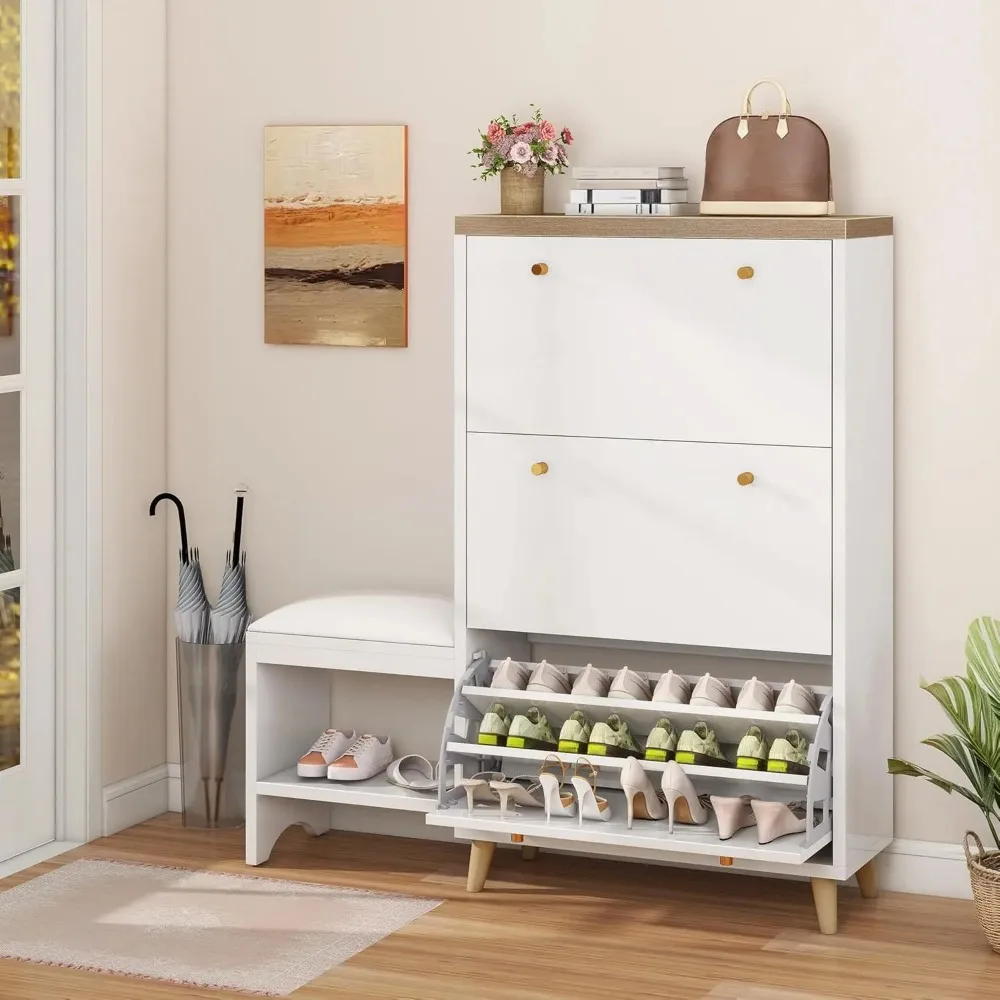
For homes with extremely limited entry space, our narrow entryway bench collection offers solutions starting at just 8-10 inches (20-25 cm) in depth while still providing essential seating and storage. These ultra-slim designs prove that even the most constrained spaces can accommodate functional organization.
When selecting furniture for tiny spaces, reviewing our complete guide to choosing compact bench options helps identify the perfect balance between size and functionality. The most effective tiny-space solutions often incorporate multiple space-saving techniques simultaneously.
Practical Maintenance Strategies for Long-Lasting Organization
Even the best storage system will fail without proper maintenance. Implementing simple routines ensures your mudroom stays organized and functional for years to come.
Daily Quick-Tidy Routines
Establish these 5-minute habits:
- Reset hooks and hanging items before bed
- Return loose items to designated containers
- Wipe down high-touch surfaces
- Check for and handle wet items properly
- Clear the floor completely for easy cleaning
These simple daily actions prevent clutter from accumulating and becoming overwhelming. The most effective routines happen at consistent times—either before bed or before leaving the house in the morning.
Weekly and Seasonal Assessments
Deeper organization requires regular attention:
- Weekly: Empty and clean containers, reorganize misplaced items, and wipe down all surfaces
- Monthly: Assess what’s working and what needs adjustment in your system
- Seasonally: Rotate seasonal items, deep clean all storage components, and evaluate if current systems still meet your needs
Material-Specific Maintenance
Different materials require different care:
- Wood: Clean with appropriate wood cleaners and re-oil or condition periodically
- Metal: Check for rust or corrosion, especially on hooks and hardware
- Fabrics: Launder washable items regularly and vacuum others
- Plastics: Clean with mild soap and check for cracking or weakening
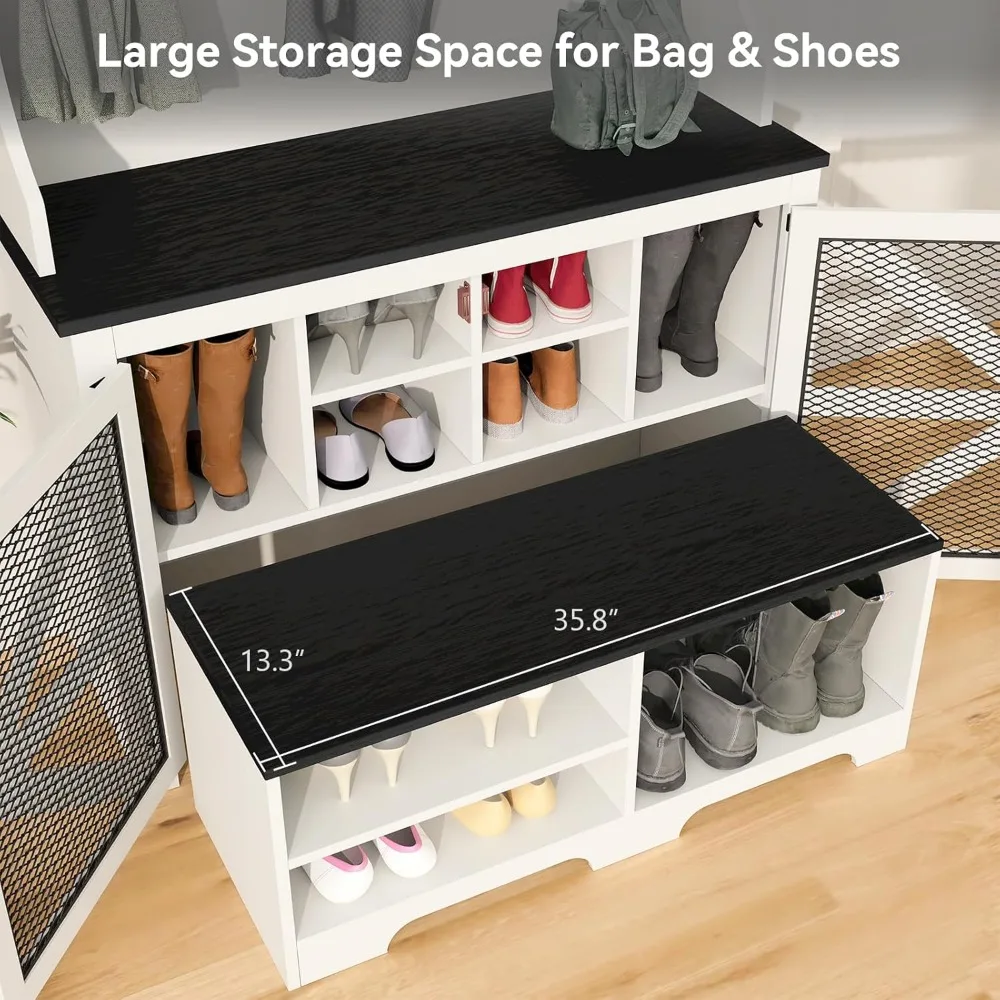
Quality materials require less frequent maintenance while maintaining their appearance and functionality. Premium products from our collection feature durable construction that withstands years of daily use with minimal maintenance requirements.
For comprehensive maintenance strategies, explore our guide to smart storage solutions for mudrooms, which includes detailed care instructions for various materials and storage types. The most successful organization systems evolve alongside your household’s changing needs while remaining fundamentally sound.
Transforming Your Small Mudroom: Where to Begin
With so many potential solutions, knowing where to start can be overwhelming. This simple assessment and action plan will help you implement changes in a logical, manageable sequence.
Assessment Questions
Begin by asking yourself:
1. What are the 3-5 most frustrating aspects of your current entryway?
2. Which family members use this space most heavily?
3. What items absolutely must be stored in this area?
4. What’s your budget for immediate improvements?
5. What’s your timeline for implementation?
Your answers will guide your priorities and help you focus on solutions that deliver the greatest impact for your specific situation.
First Investment Recommendations
For maximum impact, invest first in:
1. Wall organization systems – These deliver significant organizational benefit with minimal space requirements
2. A quality storage bench – This foundational piece serves multiple functions
3. Appropriate containers – These maintain organization within larger storage pieces
Subsequent phases can add refinements and address secondary storage needs once the core system is established.
Implementation typically occurs in stages:
* Weekend Project: Basic hook installation and container organization
* 1-2 Weeks: Furniture delivery and assembly
* 1 Month: Complete system with all components working together
Begin your transformation journey with our guide on how to organize small entryway bench areas effectively. This resource provides step-by-step guidance for establishing the foundation of your new organization system.
Remember that the perfect mudroom evolves over time. Start with the essentials that address your most pressing pain points, then refine and add as you observe how the space functions for your family. With thoughtful planning and quality components, even the smallest mudroom can become an organized, functional, and stylish entryway to your home.

